By forumite Foxilized (edited by Horridus)
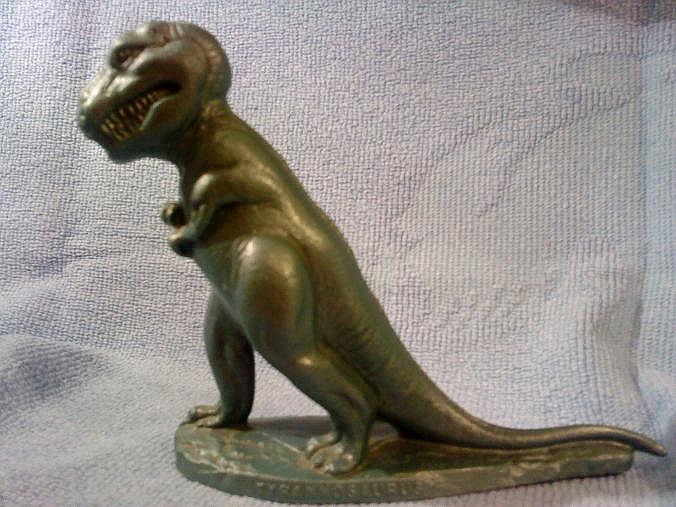
Historical background
The oil company Sinclair (USA) was, since its very beginnings in the new born 20th century, closely related to dinosaur imagery. They chose a “Brontosaurus” –yes, not the deceptive one but the thunder lizard instead- as the main logo to sell their oil. The reason was because it was seen as big and powerful, attributes which of course any company desires to be identified with, but also because they claimed their oil was really ancient, and probably made with the remains of true dinosaurs. So, they were sorta selling the idea that you would be filling your car with dinosaur essence. Who on Earth wouldn’t prefer driving with dinosaur power? The idea was so succesful the company still use the same old-fashioned tail dragging thunder behemoth as their logo today.

Sinclair, in their obsessive desire to be identified with dinosaurs, became one of the most important popularisers of palaeontology in history. Way before ‘Jurassic Park’ (and even before ‘The Flinstones’), American audiences knew the delights of introducing Mesozoic monsters into their daily lives through an exhibition produced by Sinclair in 1933. Following the great paleoartist Charles R. Knight’s works, a bunch of life-sized dinosaur sculptures were built and displayed outdoors, and millions of families enjoyed being terrified and amazed by the look of those creatures, seen for the very first time in all their – at the time – scientifically accurate splendour.
The Sinclair Company would repeat this success a few decades later, in 1964. This time the company took advantage of the World’s Fair universal exposition that was going to be on in New York, and prepared ‘DINOLAND’, with a new set of dinosaur sculptures. These were also life-sized and scientifically accurate –again, at the time… well, not really, but we all know how hard to swallow the bizarre birdie-dinosaur propositions of that odd bunch of hippies were…
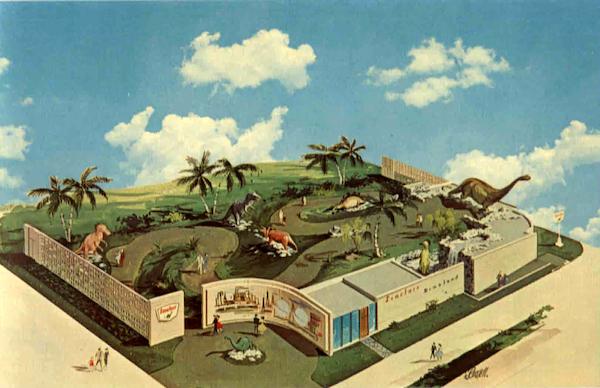
The oil company recruited Louis Paul Jonas, who had worked at several museums building sculptures, and was also a close friend of Charles Knight. Louis Paul Jonas’ intention was to sculpt dinosaurs that would follow the look of those in his pal’s old paintings, but this time trying to add a groovy ’60s feel to them. So, we got for example a tail-dragging “Trachodon” with a psychedelic colour pattern that Andy Warhol would have been proud of. The complete set included a must-have Tyrannosaurus, a must-have-too Triceratops, a Corythosaurus, a “Trachodon”, an Ankylosaurus, a “Brontosaurus”, a Struthiomimus and also of course the good old Stegosaurus. The exposition toured through the States during the next few years and, simultaneously entertaining and educational, it was another direct precedent for ‘Jurassic Park’ in terms of the succes of ‘dinomania’.

And with dinomania… came the hunger for dino-toys! And here we are. Knowing that dinosaur merchandise would sell like cold beer in the Gobi Desert, a number of Mold-A-Rama machines were placed all over the Dinoland exhibition. Those machines allowed, after inserting a coin, to choose a dinosaur figure from a list and watch how the machine created the toy in front of your eyes. In minutes, some liquid waxy-plastic material was poured inside a mould, and then it solidified into an accurate copy of the Tyrannosaurus rex sculpture from the exhibition!

The complete set of figures included each of the life-sized sculptures…minus the Struthiomimus (d’oh!). Check them out here.
Review
After this historical review, which I sincerely hope you enjoyed reading – maybe you didn’t and jumped directly to the figure review…or maybe you jumped directly to one of Horridus’ much more fun and right-to-the-eye ones [shurely shome mishtake – Ed]…in which case you aren’t even reading this…in which case I’m talking to nobody…in which case I definitely need to get out more…we arrive at the SINCLAIR MOLD-A-RAMA TYRANNOSAURUS review. It’s compared in size below with the equally retro little Schleich –which interestingly enough, appears to be based on the very same old painting by Charles Knight as the Sinclair one.
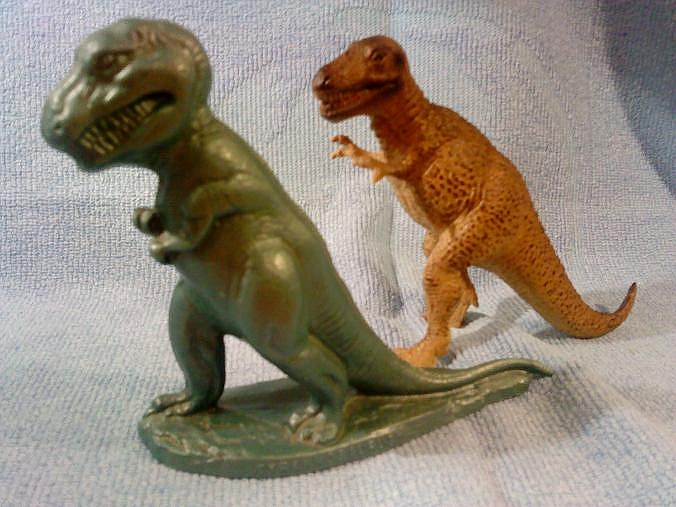
As aforementioned, the figure is made of some kind of waxy plastic. It’s hollow on the inside, which makes the figure a little bit delicate, and it must be treated with loving care.
Colours vary, with the originals from the Dinoland exposition much more bright and Jefferson Airplane-ish (blue, pink, green, orange…). The Mold-A-Rama machines were at the same time placed in museums and zoos, and the figures made in those other places appear to have a less strident colour. The figure has a base where the name of the animal is, on one side, and the other side was where the Mold-A-Rama machine was placed.
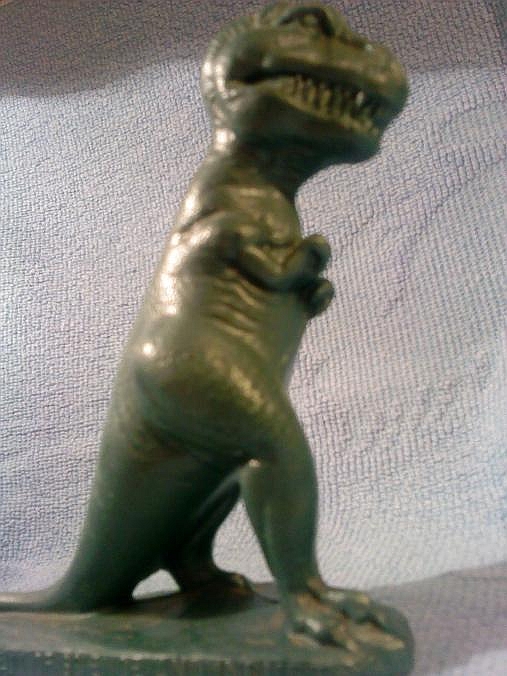
Even though I previously said that the figures were the perfect small twins of the giant sculpts of the expo, this is really not so. The life-sized sculpts were pretty realistic –you know what I mean – since these intented to portray life-like animals. The plastic figures were thought to be toys for kids. Simple as that. Therefore, they look sort of cartoonish and in the particular case of the T. rex, he resembles a psychopathic Barney. Giant round head, neck growing right UNDER the head –just like a monstrous human instead of a theropod, it would perfectly fit in a kaiju flick. Of course, he is such a good old tail dragger.
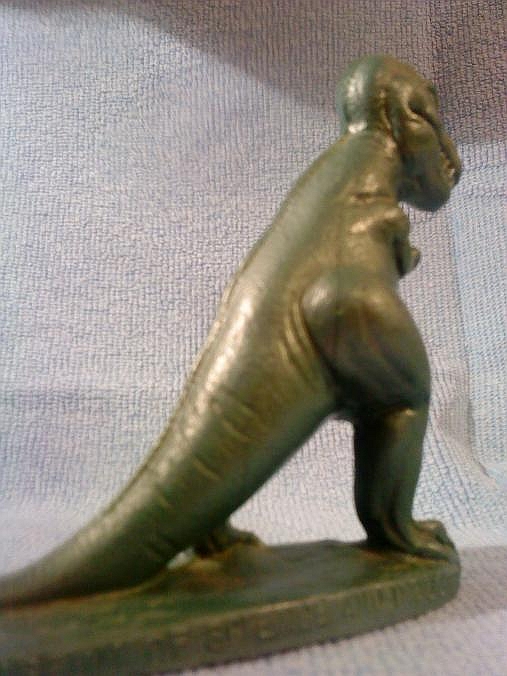
The head sculpt is detailed enough to make the figure worth owning. Sorry for the bad quality pics (mobile phone…) but in person the head looks really good. It has very well defined teeth, nostrils, eyes, even ears. All that, as said, not very realistic but still creating a charming beast (with a very bad-ass attitude, as every kid wants!). The body is, obviously, much less detailed, with only the generic skin folds here and there. There’s a thin line of osteoderms along the dorsal spine of the animal, from neck to tail. The rex is in a walking pose, though there’s not really too dynamism there, more the straight and static position of a model waiting for the camera flashes.
Finally, it’s worth mentioning that compared to the other Mold-A-Rama figures, the rex is surprisingly the smaller one. A curious thing is the Triceratops figure is like two times bigger in comparison, and that makes a sort of strange diorama when you place these two together for the all time classic battle, where a very crazy short Rexie approaches an hyperbulked Trike for no other apparent reason than dying in a very un-epic way.
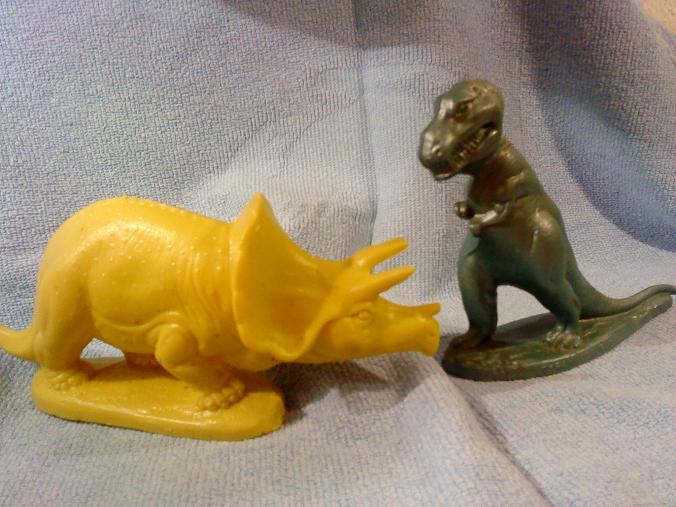
If you are sensitive enough, you surely feel sympathethic towards this freaky looking fella as soon as you look at him. You can find the rex on eBay, they aren’t too abundant but with patience you will hunt one for sure. Yes, usually at not too cheap prices –which is ironic, when you think that the figure had to cost only a few cents back in the ’60s. Keep in mind, though, that this is a very, very rare figure and also a true antique. A highly collectible item, and definitely a valuable little piece of dinosaur history.
Disclaimer: links to Ebay and Amazon on the DinoToyBlog are affiliate links, so we make a small commission if you use them. Thanks for supporting us!




[…] the Field Museum in Chicago. For a brief history of Dinoland and the World’s Fair check out the review of the original Tyrannosaurus written by […]
[…] been reviewed there really isn’t much new to say about this one. DTF member “Foxilized” reviewed the original back in 2010. For the sake of consistency though I feel compelled to share my thoughts too, I’ve […]
[…] at Chicago’s Field Museum. For more on the history of Mold-A-Rama, and the World’s Fair check out the write-up that accompanies the review of the original World’s Fair […]
[…] souvenirs at the World’s Fair in 1964, right on the cusp of the Dinosaur Renaissance. DTF member Foxilized wrote much about the history of Sinclair and the World’s Fair in his review of the Mold-A-Rama […]
I was about eight years old when I saw the Sinclair exhibit at the NY World’s Fair, and got a model hot from the Mold-A-Rama. What I remember best is my disappointment at how quickly it fell apart. It also had gaps from air bubbles in the plastic, which must have been a bad batch. I have fonder memories of the inflatable green vinyl dinos my brother and I took to the beach – Sinclair promotional items that my Dad got at the gas station. As the eldest, I had the earlier model, which resembled the Bronto logo; my brother’s, which came later, was a generic biped with a dragon’s tail and a peaked cap, ready to fill your tank. They survived several summers before going extinct (along with gas station attendants in peaked caps).
We recently discovered a working machine originally operated by Mold-A-Rama in the 1960s, and for one year will be REVIVING the fun of the 60s and early 70s with these machines. Check out MOLDVILLE.com (use Firefox browser-problems with Internet Explorer). Or go to the FACEBOOK page of the same name (MOLDVILLE.com)! Do it!
Charles, thanks for your testimony. That was quite interesting to read. Glad to see my article inspired those lovely memories. 🙂
Just an added remark here about Sinclair’s DinoLand… I attended the 64-65 New York World’s Fair as a kid and was completely blown away by the exhibit; so much so, in fact, that I pretty much insisted that my parents also take us to visit the DinoLand exhibit several times as it toured the USA for a few years afterwards.
I haven’t seen many night-time photos of the Sinclair Dinoland exhibit, but THAT was when you wanted to see these monsters, at night, well after sunset, when they were illuminated with multi-color uplighting. By daylight the exhibits were impressive, to be sure; but by night, with uplighting, they came alive and were quite horrifying.
That’s the way I’ll always remember them.
Does anyone know if the AMNH carried any of the Sinclairs back in 1969/70 for its 100th Anniversary?
I really enjoyed reading this! Very interesting historical background too. 🙂
Er, thanks Dan. I guess. 😛
Foxilized wrote it, I just tidied up the English a bit!
Now that’s a review. Bang-up job, Marc.
That scale difference between the Rex & Trike is interesting-several years back I visited Chicago’s FMNH and picked up 4 Mold-a-Rama dinos (Rex, Trike, Bronto & Steg). For whatever reason, my Trike was a far smaller (i.e. safer) match for Rexy. Nor were these guys especially pricey fresh off the mold-most likely $1.50 US, though memory fails me here.
Anyhow, nice historical blurb, fine review, and this guy certainly has more Knight-derived charm than many of his mass-market contemporaries (or successors).
You may also be able to find Mold-A-Rama machines in museums and zoos, still carrying this line – I know I’ve seen the Brontosaurus machine at the Brookfield Zoo and the Field Museum, near and in Chicago respectively; and I’m pretty sure I saw the T. Rex machine at the Field Museum as well. It’s been a few years since I attended either venue, though, so they may have been removed in the last 5 years or so.
That Mold A Rama thing is really interesting. It was probably fun to use too.